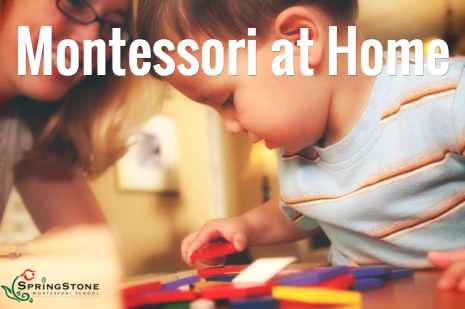The five distinct areas of a Montessori classroom
Let’s take a deeper look at the five distinct areas of a Montessori classroom and their specific focus in supporting a child’s development in all areas of development.
Sensorial
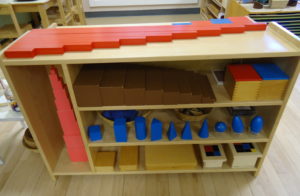
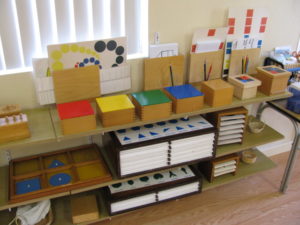
The Sensorial area of the classroom helps children become more aware of smaller details that are often overlooked. Each sensorial activity focuses on one important quality such as color, weight, shape, size, texture, sound or smell. Sensorial activities develop the senses of perception and discrimination for exploring and noticing small differences in patterns. They also focus on fine motor function development in the hands. The sensorial area builds the child’s concentration, awakening the senses and perception to distinguish different qualities and patterns.
Practical Life
The Practical Life area is essential for a strong Montessori educational foundation. In this area, a child is learning control of movement (fine motor skills), concentration span, self-confidence, and a love of learning. The activities in Practical Life are made up of familiar objects that a child would naturally see in everyday life. The activities are designed and chosen so that the children feel comfortable and will be able to master the activity. The activities that are chosen fall into four main categories:
– Care of self,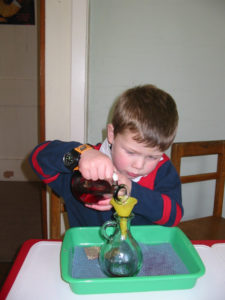
– Control of movement,
– Care of the environment,
– And Grace and Courtesy.
The overall objective of these activities is to help children gain self-confidence in their working abilities. Practical Life activities expose children to fundamental activities that will build their concentration span. Children are working with activities they will encounter through adulthood.
Language

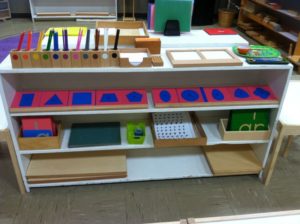 The Language area of the Montessori classroom encourages development of early-literacy skills through the use of phonetic sounds. Montessori Language activities are designed to improve a child’s vocabulary, develop listening skills for common sounds and the ability to differentiate between objects and pictures.
The Language area of the Montessori classroom encourages development of early-literacy skills through the use of phonetic sounds. Montessori Language activities are designed to improve a child’s vocabulary, develop listening skills for common sounds and the ability to differentiate between objects and pictures.
Language activities include learning the shapes and sounds of letters, practicing fine motor skills by writing, vocabulary development, matching words and pictures, reading development with word lists, practicing parts of grammar (nouns, verbs, adjectives, etc.) and creating sentences and reading silently.
Math
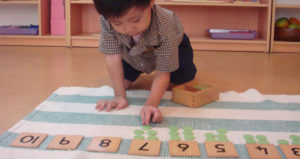
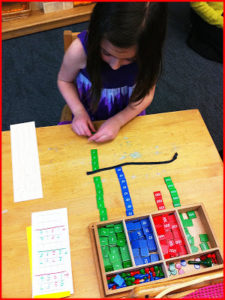
The Math area of the Montessori classroom encompasses the use of concrete materials for the recognition of numbers and association of quantity as well. Through these activities, children learn exactly how much a symbolic number stands for (i.e. the number 5 means counting the correct number of objects to make the number 5). Mathematics activities are divided into six categories that include: counting and the decimal system, memory work, concrete abstraction, arithmetic tables and geometry. Children are introduced to more complex mathematical procedures and concepts as they are individually ready. Often times a child will complete a mathematical activity a few times until they feel ready to attempt a concept that is more difficult.
Cultural
The Cultural area of the classroom encompasses a variety of subjects that are supplementary to the Montessori method. Cultural subjects include: Geography, Zoology, Botany, Science, Art & Music and Spanish. Studying these subjects provide children an opportunity to explore their curiosity of different and worldly ideas.
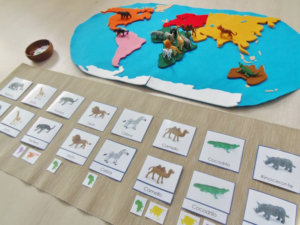 Studying Geography allows the children the opportunity to understand their own culture as well as many others. The children can relate and understand cultural diversity and ultimately come to appreciate differences between humankind.
Studying Geography allows the children the opportunity to understand their own culture as well as many others. The children can relate and understand cultural diversity and ultimately come to appreciate differences between humankind.
Science in the Montessori classroom allows the children to observe and work with hands-on experiments that will cultivate a lifelong interest in nature and discovering more about our unique world.
Through the study of Botany, the children learn about plants (what they look like, how to take care of them, how they grow, etc.) so that they may appreciate nature in a more organic way.
The study of Zoology shows children animals from all around the world (where they live, their unique Eco-systems, what they eat, how they grow, etc.)
Lastly, the study of art & music allows the children a very unique opportunity to express themselves. Children have an expressive and uninhibited experience of moving, dancing and singing among their school peers. Art & Music allows children to gain a literary understanding of language and develop their cognitive, social and emotional skills in a constructive way.

